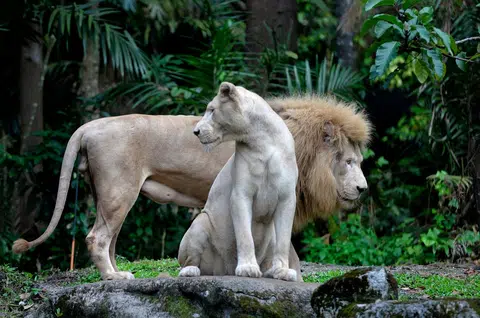Rare white lion put to sleep after signs of tumours found
A rare 15-year-old African white lion at the Night Safari was euthanised on Feb 21, The Straits Times has learnt.
In response to queries, Mandai Wildlife Group veterinarian Guillaume Douay said the lioness named Mandisa had shown signs of weight and muscle loss, as well as a reduced appetite, since early February.
A health check-up on Feb 21 revealed masses in its abdomen and the build-up of fluid, which were later confirmed to be blood from tumours.
"Unfortunately, there is no cure for this condition. Our veterinary and animal care teams then made the difficult decision to euthanise her on medical and welfare grounds," said Dr Duoay, who co-chairs Mandai's Animal Welfare Scientific Advisory Group.
An examination of Mandisa's carcass confirmed the presence of cancer, which had spread to multiple organs, he added.
Cancer is more common in aged animals like Mandisa, which had been on the group's senior animal care plan that aims to help animals age comfortably while maintaining a good quality of life.
Said Dr Douay: "Our teams continually assess the welfare of each animal, and when age-related issues become too severe to manage through treatment or care, euthanasia is considered the most compassionate option."
Despite the white lion's unique appearance, it is considered to be the same species as the traditionally tawny African lion.
The iconic white coat owes its colouration to a rare genetic mutation, much like the occurrence of blue eyes in humans, according to non-profit Global White Lion Protection Trust.
White lionesses typically live up to 16 years of age, according to Mandai's website.
Mandisa leaves behind its companion Sipho, a 16-year-old male white lion.
Mandisa's name comes from a word in the African language Xhosa meaning 'sweet' or 'pleasant' while Sipho is a Xhosa name derived from the word isipho, meaning 'gift'.
When combined, their names are meant to translate to a sweet gift for the Night Safari, where the mates officially debuted as part of the nocturnal park's 20th anniversary in May 2014.
Mandai Wildlife Group carnivore keeper Celeste Goh said the park's keepers came together on Feb 24 to bid farewell to Mandisa, which was loving to both its mate and carers.
She said the pair shared an "incredibly strong" bond. They did not have any offspring.
Ms Goh, who is part of the group's animal care team, said: "They were often seen showing affection for each other - rubbing heads or resting side by side in their exhibit.
"Each evening, as it was time to head into their enclosure, Mandisa would wait for Sipho, and they would walk out together."
The lioness would also rub its head against the meshing as a sign of endearment to its keepers.
Ms Goh recalled: "A highly food-motivated lion, Mandisa was quick to engage in positive reinforcement training.
"She was the first to interact with enrichment placed in the exhibit, and once she was done, she'd often go over to explore Sipho's enrichment as well."
Enrichment refers to objects that improve an animal's environment by encouraging behaviours beneficial for its mental and physical health.
With the passing of Mandisa, the keepers' focus has since shifted to Sipho, which "appears to be adjusting well and is doing okay" so far, said Ms Goh.

She added: "As Sipho is also ageing, we are closely monitoring him for any age-related issues to ensure his continued well-being."
African lions are considered globally vulnerable to a host of threats, including declining natural prey and habitat loss, but uncertainty remains whether conservation efforts are sufficient to halt the decline in populations.
However, naturalists have also argued that there is an urgent need to prioritise the conservation of white lions, which are rarer due to their genes.
The Global White Lion Protection Trust estimates that there are fewer than 20 white lions in the wild in their natural habitat.
Ang Qing for The Straits Times